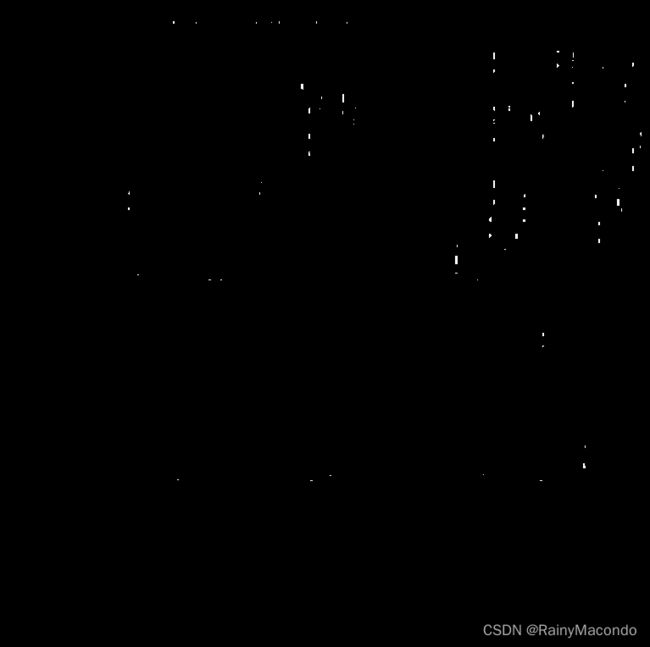【学习日记】图像网格条纹去除算法总结
参考资料:
opencv线检测
https://docs.opencv.org/4.x/dd/dd7/tutorial_morph_lines_detection.html
霍夫变换线检测
https://docs.opencv.org/4.x/d9/db0/tutorial_hough_lines.html
fft
https://blog.csdn.net/crystal_remember/article/details/117330680
https://blog.csdn.net/weixin_39450742/article/details/118354529
https://blog.csdn.net/stq054188/article/details/113133533
陷波滤波器
https://blog.csdn.net/weixin_40267472/article/details/81385751
https://blog.csdn.net/weixin_43048780/article/details/121090685
isect_segments-bentley_ottmann 算法
https://github.com/ideasman42/isect_segments-bentley_ottmann
https://stackoverflow.com/questions/45322630/how-to-detect-lines-in-opencv
fft方法
需要手动标注,并做阈值分割等后处理
% https://blog.csdn.net/Crystal_remember/article/details/117330680
close all;
clear all;
clc;
%%
I = imread('test.bmp');
I = rgb2gray(I);
totMask = zeros(size(I)); % accumulate all single object masks to this one
f = figure('CurrentCharacter','a');
imshow(I)
FFT = fft2(I);
myangle = angle(FFT); %相位谱(没有进行移位的)
FS = abs(fftshift(FFT)); % 移位,使低频成分集中到图像中心,并得到幅度谱
S = log(1+abs(FS));
figure,imshow(S,[]);
small=min(min(FS));
h = imfreehand(gca); setColor(h,'green');
position = wait(h);
BW = createMask(h);
totMask = totMask | BW; % add mask to global mask
while double(get(f,'CurrentCharacter'))~=27
% ask user for another mask
h = imfreehand(gca);
if isempty(h)
% User pressed ESC, or something else went wrong
continue
end
setColor(h,'green');
position = wait(h);
BW = createMask(h);
totMask = totMask | BW; % add mask to global mask
pause(.1)
end
% show the resulting mask
% figure; imshow(totMask); title('multi-object mask');
cost3 = FS;
cost3(totMask == 1) = small ;
FS = cost3;
resul_s = ifftshift(FS); % 将处理后的幅度图反移位,恢复到正常状态
result_f = resul_s.*cos(myangle) + resul_s.*sin(myangle).*1i; % 幅度值和相位值重新进行结合,得到复数
result_image = abs(ifft2(result_f )); % 进行傅里叶反变换,得到处理后的时域图像
result = im2uint8(mat2gray(result_image));
figure,imshow(result); %去除网纹成分后的图像
%------
BW = imbinarize(result,0.8); % 二值化分割
figure,imshow(BW);
概率霍夫线检测算法
# https://docs.opencv.org/4.x/d9/db0/tutorial_hough_lines.html
import sys
import math
import cv2 as cv
import numpy as np
def main(argv):
default_file = 'test.bmp'
filename = argv[0] if len(argv) > 0 else default_file
src = cv.imread(cv.samples.findFile(filename), cv.IMREAD_GRAYSCALE)
if src is None:
print ('Error opening image!')
print ('Usage: hough_lines.py [image_name -- default ' + default_file + '] \n')
return -1
# Edge detection
dst = cv.Canny(src, 0, 150, None, 3)
# Copy edges to the images that will display the results in BGR
cdst = cv.cvtColor(dst, cv.COLOR_GRAY2BGR)
cdstP = np.copy(cdst)
# Standard Hough Line Transform
# rho: 参数的分辨率r以像素为单位
# 返回值lines为结构体数组,包含端点1、2, 角度, rho
# lines = cv.HoughLines(dst, 10, np.pi / 180,
# 150, None, 0, 0)
# # Draw the lines
# if lines is not None:
# for i in range(0, len(lines)):
# rho = lines[i][0][0]
# theta = lines[i][0][1]
# a = math.cos(theta)
# b = math.sin(theta)
# x0 = a * rho
# y0 = b * rho
# pt1 = (int(x0 + 1000*(-b)), int(y0 + 1000*(a)))
# pt2 = (int(x0 - 1000*(-b)), int(y0 - 1000*(a)))
# cv.line(cdst, pt1, pt2, (0,0,255), 3, cv.LINE_AA)
# Probabilistic Line Transform
# 累计概率霍夫变换
# 用法:(image, rho, theta, threshold,
# lines=None, minLineLength=None, maxLineGap=None)
linesP = cv.HoughLinesP(dst, 10, np.pi / 180, 150,
None, 500, 20)
# Draw the lines
if linesP is not None:
for i in range(0, len(linesP)):
l = linesP[i][0]
# (img, pt1, pt2, color, thickness=None, lineType=None, shift=None)
cv.line(cdstP, (l[0], l[1]), (l[2], l[3]), (0,0,255), 5, cv.LINE_AA)
# 阈值分割 mask
# 150以上的设为全黑
ret, mask = cv.threshold(src, 50, 255, 1) #简单二值化
cv.imwrite("1-mask.png",mask)
# 对霍夫P变换检测到的线作为二次判断条件
# print(cdstP[0,0,0])
# print(cdstP.shape)
# print(cdstP[1256,1257])
# print(cdstP[1256,1257][2])
# for i in range(cdstP.shape[0]):
# for j in range(cdstP.shape[1]):
# flag = (cdstP[i, j][0] == 0) & (cdstP[i, j][1] == 0) & (cdstP[i, j][2] == 255)
# if flag:
# cdstP[i, j] = (255,255,255)
# else:
# cdstP[i, j] = (0,0,0)
for i in range(cdstP.shape[0]):
for j in range(cdstP.shape[1]):
# 对于阈值分割结果mask:如果认为是网格,像素值设置为0(全黑);否则不处理
flag = (cdstP[i, j][0] == 0) & (cdstP[i, j][1] == 0) & (cdstP[i, j][2] == 255)
if flag:
mask[i, j] = 0
else:
pass
# Show results
cv.imshow("Source", src)
# cv.imshow("Standard Hough Line Transform", cdst)
cv.imshow("Probabilistic Line Transform", cdstP)
cv.imshow("threshold", mask)
cv.imwrite("2-HoughLinesP.png",cdstP)
cv.imwrite("3-result.png",mask)
cv.waitKey()
return 0
if __name__ == "__main__":
main(sys.argv[1:])
bentley-otmann算法
# https://stackoverflow.com/questions/45322630/how-to-detect-lines-in-opencv
import cv2
import numpy as np
import isect_segments_bentley_ottmann.poly_point_isect as bot
img = cv2.imread('test.bmp')
gray = cv2.cvtColor(img,cv2.COLOR_BGR2GRAY)
kernel_size = 5
blur_gray = cv2.GaussianBlur(gray,(kernel_size, kernel_size),0)
low_threshold = 0
high_threshold = 150
edges = cv2.Canny(blur_gray, low_threshold, high_threshold)
rho = 1 # distance resolution in pixels of the Hough grid
theta = np.pi / 180 # angular resolution in radians of the Hough grid
threshold = 15 # minimum number of votes (intersections in Hough grid cell)
min_line_length = 50 # minimum number of pixels making up a line
max_line_gap = 20 # maximum gap in pixels between connectable line segments
line_image = np.copy(img) * 0 # creating a blank to draw lines on
# Run Hough on edge detected image
# Output "lines" is an array containing endpoints of detected line segments
lines = cv2.HoughLinesP(edges, rho, theta, threshold, np.array([]),
min_line_length, max_line_gap)
print(lines)
points = []
for line in lines:
for x1, y1, x2, y2 in line:
points.append(((x1 + 0.0, y1 + 0.0), (x2 + 0.0, y2 + 0.0)))
cv2.line(line_image, (x1, y1), (x2, y2), (255, 0, 0), 5)
lines_edges = cv2.addWeighted(img, 0.8, line_image, 1, 0)
print(lines_edges.shape)
#cv2.imwrite('line_parking.png', lines_edges)
print(points)
intersections = bot.isect_segments(points)
print(intersections)
for inter in intersections:
a, b = inter
for i in range(3):
for j in range(3):
lines_edges[int(b) + i, int(a) + j] = [0, 255, 0]
cv2.imwrite('line_parking.png', lines_edges)

